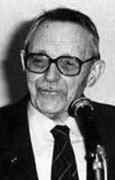Person: Rocard, Yves-André

Yves-André Rocard was a French physicist who worked in a variety of fields including radio-astronomy and development of the French atomic bomb.
Mathematical Profile (Excerpt):
- Yves had a problem which became evident when he was five years old - he was deaf.
- Rocard attended the Lycée Louis-le-Grand in Paris before entering the École Normale Supérieure in 1922.
- These five were Yves Rocard, André Weil, Jean Delsarte, Paul Labérenne (1902-1985), and Jean Barbotte.
- However, Rocard did not think highly of the education he received at the École Normale Supérieure.
- For example, the library at the École was closed on Sundays so Rocard put his shoulder to the rickety old library door and forced his way in.
- At the age of 25, Rocard predicted the Raman effect theoretically.
- After the award of his two doctorates, Rocard spent ten years working in industry with a parallel academic career.
- Rocard worked in their Research Laboratories, in particular cooperating with the physicist Maurice Ponte (1902-1983).
- In this role, Rocard contributed to the development of the pentode, a vacuum tube widely used in electronic equipment before the invention of the transistor.
- On the academic side, Rocard was selected to give the Cours Peccot.
- The Caisse Nationale des Sciences was founded in 1930 and, two years later, Rocard was appointed as a senior scientist.
- Their son, Michel Rocard was born on 23 August 1930.
- Yves and Renée Rocard were divorced on 20 June 1963.
- Returning to Rocard's academic career, in 1938 he was appointed as a lecturer in physics at the Faculty of Science at Clermont-Ferrand.
- This was to prove a significant time for Rocard in the development of his scientific ideas, for at this time he learnt that radars in England had been shown to have detected strong radio emission from the Sun.
- After the war, Rocard returned to France and proposed that France set up a site to conduct radio astronomy.
- Rocard was even able to get his hands on equipment to start off such a project, providing two German radar mirrors of 'Wurzburg' type each having a 7.5 meter diameter.
- Using his wartime contacts, Rocard was able to give his scientists access to the Research Centre of the French Navy at Marcoussis.
- Rocard gave strong support to the project and the French Ministry of National Education gave 25 million Francs to the École Normale Supérieure.
- In addition to his work on radio astronomy, Rocard contributed to the development of the French atomic bomb.
- Professor Rocard, who had been the French representative at the Conference of Experts, was a professor of physics at the University of Paris.
- Rocard had made measurements of EMP (electromagnetic pulse) generated by the first French atomic test, a shot on a tower in the Sahara in what is now Algeria.
- Rocard also visited us in the United States.
- Let us look briefly as some of the many books that Rocard published.
- Basing his extensions on Professor Chapman's work, M Rocard has himself made valuable contributions to the subject in recent years.
- In 1941 Rocard published Théorie des Oscillateurs Ⓣ(Theory of Oscillators).
- Rocard published Dynamique Générale des Vibrations Ⓣ(General dynamics of vibrations) in 1943.
- A number of people who met Rocard in the 1960s wrote about their experiences and from these we gain some insight into Rocard's character.
- Rocard was inviting us for lunch.
- Also Rocard himself, perhaps the most powerful physicist in France, cultivating the look of a schoolmaster in a nineteenth century provincial college.
- Rocard suffered from kidney problems towards the end of his life.
Born 22 May 1903, Vannes, France. Died 16 March 1992, Paris, France.
View full biography at MacTutor
Tags relevant for this person:
Astronomy
Thank you to the contributors under CC BY-SA 4.0! 

- Github:
-

- non-Github:
- @J-J-O'Connor
- @E-F-Robertson
References
Adapted from other CC BY-SA 4.0 Sources:
- O’Connor, John J; Robertson, Edmund F: MacTutor History of Mathematics Archive
